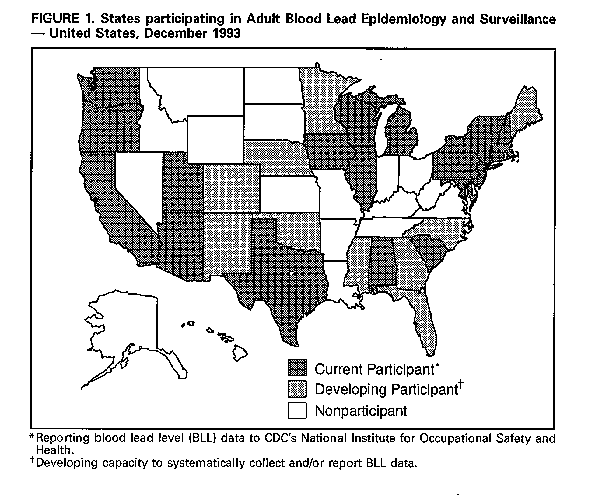 |
|
|
|
|
|
|
| ||||||||||
|
|
|
|
|
|
|
||||
| ||||||||||
|
|
|
|
|
Persons using assistive technology might not be able to fully access information in this file. For assistance, please send e-mail to: mmwrq@cdc.gov. Type 508 Accommodation and the title of the report in the subject line of e-mail. Adult Blood Lead Epidemiology and Surveillance -- United States, Third Quarter, 1993CDC's National Institute for Occupational Safety and Health (NIOSH) Adult Blood Lead Epidemiology and Surveillance (ABLES) program monitors elevated blood lead levels (BLLs) in adults in the United States. Laboratories report results of testing for BLLs to state-based lead surveillance programs, and results are compiled each quarter by NIOSH (1). Twenty states currently report results to NIOSH (Table_1). Ten additional states (Colorado, Florida, Georgia, Maine, Minnesota, Mississippi, Nebraska, New Mexico, North Carolina, and Oklahoma) are developing the capacity to systematically collect and/or report elevated BLL data (Figure_1). Programs in 30 states now have or are implementing 1) regulations specifying a reportable BLL in adults; 2) requirements that laboratories report elevated BLLs to appropriate state agencies; 3) protocols for investigating reported cases; and 4) mechanisms for linking case reports with follow-up activities (e.g., educational efforts and epidemiologic field investigations). Reports based on data from ABLES have not included analysis of trends because of the incremental development of the surveillance system (i.e., yearly addition of participating states) and the availability of complete data for only 1 year (1992). However, the availability of data for 1993 will enable analysis of trends for a 2-year period (1992-1993). Reported by: NH Chowdhury, MPH, Alabama Dept of Public Health. C Fowler, MS, Arizona Dept of Health Svcs. FJ Mycroft, PhD, Occupational Health Br, California Dept of Health Svcs. BC Jung, MPH, Connecticut Dept of Public Health and Addiction Svcs. M Lehnherr, Occupational Disease Registry, Div of Epidemiologic Studies, Illinois Dept of Public Health. R Gergely, Iowa Dept of Public Health. E Keyvan-Larijani, MD, Lead Poisoning Prevention Program, Maryland Dept of the Environment. R Rabin, MSPH, Div of Occupational Hygiene, Massachusetts Dept of Labor and Industries. A Carr, MBA, Bur of Child and Family Svcs, Michigan Dept of Public Health. D Solet, PhD, Div of Public Health Svcs, New Hampshire State Dept of Health and Human Svcs. B Gerwel, MD, Occupational Disease Prevention Project, New Jersey State Dept of Health. R Stone, PhD, New York Dept of Health. M Barnett, MS, State Health Div, Oregon Dept of Human Resources. J Gostin, MS, Occupational Health Program, Div of Environmental Health, Pennsylvania Dept of Health. R Marino, MD, Div of Health Hazard Evaluations, South Carolina Dept of Health and Environmental Control. DM Perrotta, PhD, Environmental Epidemiologist, Texas Dept of Health. D Beaudoin, MD, Bur of Epidemiology, Utah Dept of Health. L Toof, Div of Epidemiology and Health Promotion, Vermont Dept of Health. J Kaufman, MD, Washington State Dept of Labor and Industries. D Higgins, Wisconsin Dept of Health and Social Svcs. Div of Surveillance, Hazard Evaluations, and Field Studies, National Institute for Occupational Safety and Health, CDC. Reference
TABLE 1. Reports of elevated blood lead levels (BLLs) in adults -- 20 states, * third
quarter, 1993
===================================================================================================
Third quarter, 1993
Reported BLL --------------------------- Cumulative Cumulative
(ug/dL) No. reports No. persons + reports, 1993 & reports, 1992 @
---------------------------------------------------------------------------------
25-39 3,848 2,358 11,261 9,377
40-49 1,256 706 3,163 2,257
50-59 369 222 788 615
>=60 171 91 411 324
Total 5,644 3,377 15,623 12,573
---------------------------------------------------------------------------------
* Alabama, Arizona, California, Connecticut, Illinois, Iowa, Maryland, Massachusetts, Michigan,
New Hampshire, New Jersey, New York, Oregon, Pennsylvania, South Carolina, Texas, Utah,
Vermont, Washington, and Wisconsin.
+ Individual reports are based on the highest reported BLL for the person during the given
quarter.
& Data for first quarter 1993 reported from 17 states (Alabama, Connecticut, Illinois, Iowa,
Maryland, Massachusetts, Michigan, New Hampshire, New Jersey, New York, Oregon, Penn-
sylvania, South Carolina, Texas, Utah, Vermont, and Wisconsin). Second quarter 1993 reports
are from the 20 states previously described.
@ Cumulative totals for 1992 reflect first-, second-, and third-quarter data from 17 states (Ala-
bama, California, Colorado, Connecticut, Illinois, Iowa, Maryland, Massachusetts, Michigan,
New Hampshire, New Jersey, New York, Oregon, South Carolina, Texas, Utah, and Wisconsin).
===================================================================================================
Return to top. Figure_1  Return to top. Disclaimer All MMWR HTML versions of articles are electronic conversions from ASCII text into HTML. This conversion may have resulted in character translation or format errors in the HTML version. Users should not rely on this HTML document, but are referred to the electronic PDF version and/or the original MMWR paper copy for the official text, figures, and tables. An original paper copy of this issue can be obtained from the Superintendent of Documents, U.S. Government Printing Office (GPO), Washington, DC 20402-9371; telephone: (202) 512-1800. Contact GPO for current prices. **Questions or messages regarding errors in formatting should be addressed to mmwrq@cdc.gov.Page converted: 09/19/98 |
|||||||||
This page last reviewed 5/2/01
|